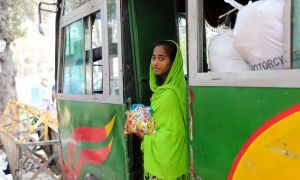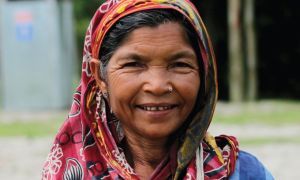
Read our 2023 annual report

Knowledge Hub
Integrated SMART Nutrition Survey in Dhaka Urban Slums Bangladesh
Concern commissioned ACF to conduct a Standardized Monitoring and Assessment of Relief and Transitions (SMART) nutrition survey in the urban slum areas of Dhaka, Bangladesh in May and June 2022. The survey was also supported by World Food Programme (WFP) and Dhaka North and South City Corporations.

In Bangladesh, the urban context has its unique characteristics and complexities. The malnutrition levels among children and pregnant and lactating women (PLW) are expected to be quite high. The Covid-19 pandemic not only had an effect on the health situation in these areas, but also impacted several other spheres: political, social, human, environmental, economic and infrastructural. There is also a high risk of further deterioration of health and nutrition situation, access to health and nutrition services because of the Covid-19 pandemic and the increased cost of living crisis.
However, Concern noted a lack of nutritional data for children under five years and PLW living in the urban slums in Dhaka. Previous national level surveys had focused on rural areas, without a specific focus on urban slums. To address this data gap, Concern in partnership with Action Against Hunger Bangladesh and World Food Programme conducted two independent integrated nutrition surveys in Dhaka North City Corporation (DNCC) and Dhaka South City Corporation (DSCC) in May-June 2022. The assessments were authorised by the National Nutrition Services (NNS), the Institute of Public Health Nutrition (IPHN), Ministry of Health and Family Welfare (MoHFW) and the DNCC and DSCC.

Key highlights
- Global Acute Malnutrition (GAM) rate among children was found to be above the emergency thresholds (“Very High”) of >15% in DSCC slums (18.4%) and remained in the second highest category (“High”) in DNCC slums (12.8%).
- Chronic malnutrition (stunting) among children was found to be above the Very High/Critical WHO/UNICEF thresholds of >30% in DSCC slums and remained in the second highest category of >20% (“High”) in DNCC slums.
- While comparing the gender, boys were more undernourished in all forms of malnutrition (e.g. wasting, stunting and underweight) compared to girls
- Looking at the age groups older children (24-59 months) were more undernourished in all forms of malnutrition (e.g. wasting, stunting and underweight) younger children (6-23 months).
- Diarrhoea prevalence (DSCC- 20.1%, DNCC- 16.0%) among children 6-59 months was relatively high compared to the national average rate of 5.0% and was more prevalent among younger children (0-23 months).
- Poor infant and young child feeding (IYCF) practices varied with optimal (breastfeeding) and suboptimal (Complementary feeding) levels in both locations.
- Vitamin A supplementation coverage found to be below the national average (79%), except for measles vaccination (>85.0%) and deworming coverage (>64%) were found to be above the national average
- Less intake of micronutrient powder (MNP) among children 6-59 months during previous days (<1.0%).
- Crude and under-five mortality rates are well below emergency levels.
- Accessing Antenatal Care (ANC) services among pregnant women were found to be relatively high (>=85%) but iron folic acid intake was reported low.
- ANC and PNC checkups were optimal for at least one visit but were reported very low for at least four visits in both locations.
- Prevalence of acutely malnourished among pregnant and lactating women was found low.
- Majority of the households had adopted no or low coping strategy in DSCC (72.9%) and DNCC (78.3%) Slum based on Reduced Coping Strategy Index (rCSI)
- However, One-third households [DSCC: 32.1%; DNCC: 32.3%] reported with medium or severe food insecure based on Food Insecurity Experience Scale (FIES) who negatively adopted the situation through consumption-based coping strategies to deal with food shortages. This affects both the quantity and quality of food consumed.
- Households (>95.0%) access to drinking water were optimal but there remains concern about the quality of water suppy.
- Poor hand washing practices with soap during critical times except after defecation and disposing of child faeces.
- Sanitation continues to be an issue in DNCC slums as contents of latrines are mixed with nearby drain or water point with high risk of contamination of water borne disease.
- Unsafe disposal of child feaces also remains a concern in both locations which makes children susceptible to diseases transmitted via the fecal-oral route.
Recommendations and priorities
- Ensure provision of minimum package of integrated health and nutrition services from Government and NGO primary health care centre for both children and PLWs and established referral system for malnourished cases.
- Set up community based screening, detection and referral of acute malnourished children and PLWs including routine growth monitoring activities in urban slums area
- Strengthen the provision of quality nutritional treatment through exiting stabilization center or SAM corner at government health facility.
- Advocate for necessary revision of the current national CMAM guideline to consider admissions by all criteria (e.g. WHZ, MUAC and Oedema) since national protocol recommendations MUAC based programming only. This will ensure all acute malnourished children are detected and admitted for management.
- Set up community based management of acute malnutrition programmes (e.g. OTP and TSFP for SAM and MAM respectively) in urban settings with use of context specific appropriate nutrition treatment products.
- Enhance prevention programming including promotion of infant and young child feeding (IYCF) and care practices to address high levels of undernutrition.
- Develop a multi-sectoral Social Behaviour Change and Communication (SBCC) strategy for the population living in urban slums across nutrition-specific and sensitive interventions to enhance diversified food consumption in order to address the underlying causes of malnutrition.
- Strengthen routine Expanded Programme for Immunization (EPI) and ensure sensitization to enhance programmes coverage (e.g. vitamin A, immunization and deworming etc.) through community engagement.
- Strengthen initiatives at the community and household level which promote personal hygiene and sanitation (handwashing, water treatment, proper disposal of waste, etc.) to minimize the occurrence and severity of diarrhoea in children.
- Introduce food assistance programmes where needed and expand government safety net programmes for the vulnerable families living in urban slums targeting nutritionally vulnerable groups.
- Scale up WASH programmes in urban areas to help breaking the link between waterborne diseases on malnutrition of children and PLWs
- Develop nutrition strategy for urban slums under the leadership of Bangladesh National Nutrition Council (BNNC) and bring together all relevant government ministries, key stakeholders and private sectors to establish multi-sectoral linkages on health, agriculture and food, social protection, education and social affairs etc.
This publication covers aid activities implemented with the financial assistance of several donors, including Concern Worldwide, Irish Aid and World Food Programme. The ideas, opinions and comments herein are entirely the responsibility of the author(s) and do not necessarily represent or reflect the policies of any donors.




